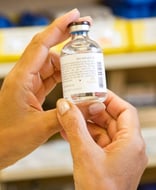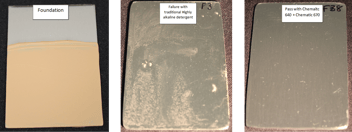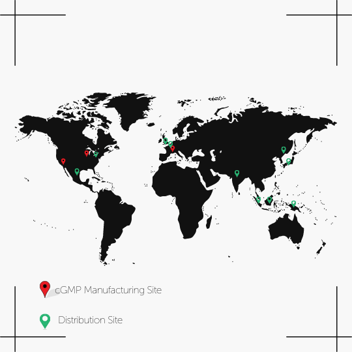How to Clean Oral Liquids and Suspensions
Oral suspensions are widely used in the Pharmaceutical and Consumer Industries as a delivery method for both over the counter and prescription drugs. Active ingredients are either dissolved or suspended in a solvent such as water, alcohol, or glycerin. Excipients are then added to modify taste and viscosity. The manufacturing of these liquids typically take place in large mixing vessels. Cleaning of the equipment is done via manual processes (scrubbing, spray wands), fill, soak and agitate processes, or automated cleaning through CIP systems and spray balls.
Challenges in Cleaning Oral Liquids and Suspensions

Difficulties in cleaning these product residues typically come from insoluble solids or viscosity modifiers. Inefficient detergents & cleaning processes do not effectively address these challenges, leading to ineffective soil removal that can require re-cleaning and manual scrubbing. Not only does it require more time and resources dedicated to cleaning, but can also add to the potential for microbial contamination.
Not only does it require more time and resources dedicated to cleaning, but can also add to the potential for microbial contamination.
Insolubles can settle out of the suspension and adhere to surfaces leaving hazes. The use of high cleaning temperatures, especially in water pre-rinses, can strip away other components of the product matrix, leaving only the pigment behind to bond with the surface. Ideally, all parts of the residue should be removed simultaneously to avoid hazes from the insoluble components. The proper detergent for products containing a high amount of insoluble solids should contain a robust surfactant and dispersant package in order to make sure that particles remain suspended and sequestered in the detergent solution, so they can effectively be flushed out of the equipment along with the cleaning solution. If possible, final rinses should be performed immediately after draining the detergent solution and ambient temperatures should be used. Hot post rinses can cause any remaining particulate to dry in place and not be effectively rinsed away.
Viscosity modifiers, such as celluloses, Sodium CMC, and xanthan gum can swell when hydrated, creating a hydrophilic layer that is difficult for detergents to penetrate, making removal less effective. When these residues dry, they become difficult to see and have the potential to build-up over time, becoming a food source for microbial contamination. If not completely removed from the surface, these residues can build up & become visible over time, also having the potential to trap particles and contaminants from subsequent batches. If these viscosity modifiers are pH dependent, it is possible for them to be overcome by using a detergent with the proper acidic or alkaline base. If they are not, detergents with oxidizing properties are often needed to remove the hydrophilic layer. If possible, it is recommended to avoid the use of water pre-rinses for these products, as hydrating the residues before the introduction of detergent promotes swelling and hinders cleaning.
Efficient Cleaning of Oral Liquids and Suspensions with Chematic® Detergents
.jpg?width=394&name=Chematic_Containers_01%20(1).jpg)
- Syrups and Suspensions made with viscosity modifiers (Sodium Carboxymethylcellulose, Xanthan Gum, Other Celluloses)
Recommended detergents: Chematic® 630, Chematic® 640, Chematic® 670
- Suspensions with Insolubles (Bismuth, Calcium, Magnesium, Insoluble APIs)
Recommended detergent: Chematic® 630
Recommended Procedure:
- Optional Water Pre-rinse at ambient to warm temperature for 10 – 15 minutes (do not use water above 50° C for pre-rinse)
- Note: Water pre-rinses should be avoided, if possible, for products containing Sodium Carboxymethylcellulose or similar components
- Dilute the detergent to ~ 5% v/v (this can be optimized between 2 – 8 % depending on the residue amount and thickness) with hot water (20 - 50° C for manual / fill, soak and agitate, ~ 50 - 65° C for CIP – Automated) and soak the equipment (soiled portion) for 30 minute – 1 hour with mild agitation / Recirculation through Spray balls in CIP equipment
- Ensure that the entire residue is covered by the detergent solution for the given time period
- For manual cleaning applications, scrubbing should be performed after the required soak time
- If a second detergent application is necessary, repeat step 2 and apply the detergent solution immediately after draining the previous step. Allowing the equipment to dry can lead to any remaining residues drying and becoming more difficult to remove.
- Immediately after draining the final detergent solution, rinse with ambient temperature water for 10-15 minutes, or until all visible detergent residue is removed.
Please note that the process steps outlined above are meant to be starting points for cleaning cycle development. To discuss a cleaning process based on your coating process and cleaning capabilities please reach out, we'd love to hear from you.





